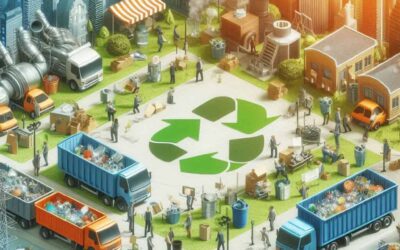What is the circular economy? The Ellen McArthur Foundation says that it is based on three principles: eliminating waste and pollution, circulating products and materials and regenerating nature.
It is also ‘underpinned by a transition to renewable energy and materials … and decouples economic activity from the consumption of finite resources.’
Transitioning from linear to circular
At the moment, much of our economy is linear. We harvest raw materials, make them into products, sell them, throw them away and start again. Raw materials are a finite resource, however, and at some point they will become scarce, causing significant price rises, and then run out altogether.
We are heading towards a tipping point where making new things just won’t be economic, sustainable or desirable. So now is the time to look at how we can better use the resources we have already harvested, and how we can substantially reduce what we throw away.
All our activities are linked. Extracting raw materials has an impact on climate, as do the processes and techniques we use to make products. When we throw things away, they end up in landfill or incinerators – all of which contributes more greenhouse gas emissions. At all stages of the process, we must look for better ways to do things.
Benefitting commercially from a circular economy
For waste and recycling companies – as for many other sectors – there is commercial gain to be made from adopting a circular economy approach. Companies can create additional revenue streams by separating and managing the waste they collect, providing a financial benefit as well as a societal one.
This works on the principle of the waste hierarchy, which is designed to reduce waste wherever possible.

Image courtesy of rethinkwaste.com.au
Waste and recycling specialists work across all but the top layer of this hierarchy and have a vital role to play in supporting and promoting the circular economy in practice. By using secondary markets for materials such as wood and steel, companies can increase revenue whilst keeping materials in circulation for reuse. Similarly, by looking at ways to recover other value from waste, companies can save additional material from disposal. And by making our recycling processes more reliable and effective, we can keep materials like glass and paper in use for longer.
Incentivising and driving change
A circular economy involves everyone from raw material companies to consumers. In his theory about the Green Premium, Bill Gates acknowledges that often a renewable, cleaner or circular alternative has a price premium associated with it. In some cases, individuals and businesses are prepared to pay this premium in order to be doing ‘the right thing’. But in many commercial cases, it’s much harder to convince businesses to pay more.
And it may be that we need some touch incentives to help people reduce their waste. For example, introducing Pay as You Throw (PAYT) schemes will concentrate people’s minds on the amount of waste they produce – leading to better consumer habits and a measurable reduction in waste. Schemes are already in place in some areas, and it’s likely that they are being considered elsewhere. If you introduce these schemes alongside rebate schemes for recycling, people are motivated to recycle more and throw away less.
Managing a circular economy business
To run a successful waste and recycling management business in a circular economy climate, you need the right information and management systems in place. Adding new revenue streams means there’s more to monitor and measure, and you’ll need to see exactly how each stream is performing at regular intervals.
The best way to do this is to invest in an integrated software system designed, built and used by people who really understand the industry. Waste & Recycling One is a dedicated solution that standardises, integrates, simplifies and automates all the waste and recycling process to create visibility, effective reporting and financial efficiencies across the business.
Further reading?
Survey | Almost 9 in 10 UK adults don’t know what the circular economy is






